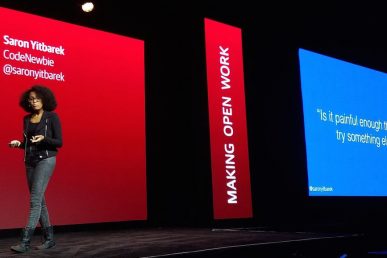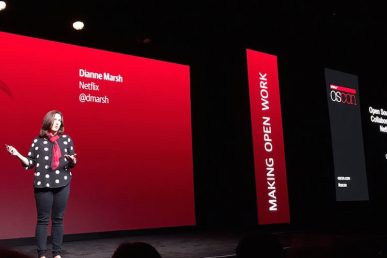AUSTIN — Rachel Roumeliotis from O’Reilly Media and Kelsey Hightower from Google opened the OSCON keynotes today reminding attendees that people build open source as much as code. Almost everything is open source, a catalyst of digital transformation. While there are lots of trends on show on the expo floor and in the sessions, open source is where innovation happens.
It was a nice segue to Evan Booth, who spends a lot of his time building stuff with other stuff. His keynote was all about building things with common components. The title of his talk, “Step 1: Punch a tree” comes from Minecraft: when you start a new game you need to collect basic components in order to make things. The first thing you have to do is punch a tree to get wood and stones. Hackers need to use tools to solve problems and they use what they have available. In the style of MacGyver or the Apollo XIII mission, or more prosaically problem solving with duct tape, Booth demonstrated his approach. With Terminalcornucopia he experimented with using common components found in gift shops after TSA security lines in airports to build weapons: the result was dangerous and got the FBI involved.
#oscon @evanbooth building weapons from things you can buy after airport security checkpoints pic.twitter.com/RilKvk6aiw
— Mike Jang (@TheMikeJang) May 10, 2017
He also showed how common components can be helpful to make things they were not designed for. Take a Keurig coffee maker, for example, and given enough time (200 hours in his case), it can be transformed into a robotic hand that can be used to hold a cup of coffee. (Very meta… he admitted.)
After taking apart so many things and reshuffling their inner guts, Booth noticed that digital and hardware share lots of similarities…. Motors, for example are the same in a microwave or a Furby toy, but those pieces are not replaceable. In software we celebrate loose coupling and with right code we can justify making that code loosely coupled.
.@evanbooth‘s #oscon keynote is as enlightening as it’s entertaining. Common components lead to great innovations.
— VM (Vicky) Brasseur (@vmbrasseur) May 10, 2017
“Why don’t we do the same with hardware?” Booth asks. “Why don’t we have a device designed to adapt its input/output to make parts easily replaceable and interchangeable?” Batteries are designed on these lines — standard voltages and sizes — but not else is. Designing around components would make things more expensive in the short term, but so much is wasted when we have to toss the whole machine if a small piece fails. What if instead of buying a whole new device you can buy pieces instead? That’s what MacGyver would want: to be able to walk into a store and buy the pieces necessary to solve the problem. Booth’s final reminder for the open source community gathered here in Austin is, “Everything you build has potential to solve issues for other things: start punching a tree.”
Stay tuned for more community news from OSCON.
- How to deploy Kubernetes on your laptop - August 3, 2018
- Why blockchains are good for the cloud, too - May 19, 2017
- Why developers need to ask more questions - May 12, 2017

)










